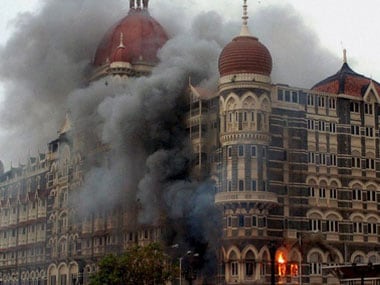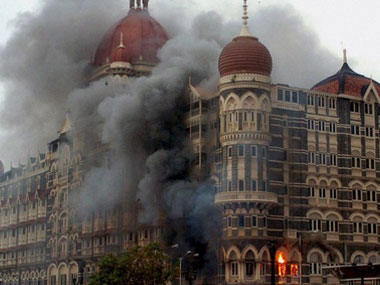A siege lasting three days, terror-struck citizens cowering in darkened stairwells, making calls to friends and family from ground zero of the attack, attempting to escape through windows, helicopters circling the site of the attack, teams of armed forces’ personnel and media personnel in readiness outside – for anybody who has lived through Mumbai’s 26/11 terror attack of 2008, the Nairobi siege has to be an eerie reminder. Besides the obvious similiarities, there are a few more – apart from the fact that the Mumbai perpetrators and the Al Shabab terrorists both have Al Qaeda links, the attackers in both cases had a safe haven in a neighbouring country. A
report in The Guardian
on the chilling similarities suggests that the November 26 terror attack on key South Mumbai locations could have inspired the Al Shabab attack on the Westgate mall. [caption id=“attachment_857027” align=“alignleft” width=“380”]
 Is another 26/11 waiting to happen? PTI[/caption] “Nairobi’s gunmen were clearly inspired by the Mumbai terror attacks in 2008, which analysts said at the time could be the template for terrorism of the future. Easier and cheaper than bombs, requiring just a handful of machine guns, plenty of ammo and a few men (and, in Nairobi, at least one woman) willing to die for their cause. And without going on full, permanent lockdown, what can cities do to prevent such an attack?” the report says. While 10 terrorists of the LeT held separate properties in South Mumbai in a siege-like situation for about 60 hours in 2008, Kenyan security forces called the battle at Westgate almost complete on the third day of the siege. “Like the Mumbai attacks, the Nairobi gunmen armed with AK 47s stormed a crowded public space spraying gunfire, tossing grenades, killing and wounding dozens and taking hostages before holing themselves up,” says
an NDTV report
, adding that the attackers in either case came from across the border. One of the cafes on the ground floor of the Westgate mall was reportedly owned by Jews and the mall frequented by foreigners. The Mumbai attackers picked the Chabad House too, an orthodox Israeli religious center, in Colaba while also attacking Café Leopold, another hub for foreign tourists. The Al Qaeda has stated clearly that its attacks will be on affluent hubs where Westerners gather. The Westgate mall was a place frequented by expats working in Kenya. Also, in either case, the terrorists appeared prepared for a two or three-day siege, the night-long sporadic gunfire taking ill-prepared security forces by surprise. While the Mumbia attackers were in touch with their handlers in Pakistan over satellite phones, the latter watching television news updates of the siege, the Nairobi gunmen and their handlers used social media to work up fear and announce their intentions. Here is what
a report in Slate
says: Meanwhile, the BBC’s Frank Gardner says the Westgate attack is similar to the Mumbai siege of 2008, when numerous low-profile targets were attacked with the goal of killing as many civilians as possible. “That prompted a complete rethink in counter-terrorism in Britain, with the realization that the UK was unprepared at the time for such a determined attack,” writes Gardner. Increasingly, observers believe that terrorists are commonly using modus operandi first tried out in India. A
report in the Times of India
points to the use of box cutters to hijack aircraft (common to both Kandahar and 9/11) and serial blasts in trains (Mumbai and London) apart from the Taj Mahal hotel-style siege at Westgate. “In fact, pictures of the attackers in the Westgate Mall in Nairobi show a stunning similarity to Ajmal Kasab and his ratpack in Mumbai - young men dressed in camouflage rampaging around with heavy weapons killing innocent civilians,” says the report.
Is another 26/11 waiting to happen? PTI[/caption] “Nairobi’s gunmen were clearly inspired by the Mumbai terror attacks in 2008, which analysts said at the time could be the template for terrorism of the future. Easier and cheaper than bombs, requiring just a handful of machine guns, plenty of ammo and a few men (and, in Nairobi, at least one woman) willing to die for their cause. And without going on full, permanent lockdown, what can cities do to prevent such an attack?” the report says. While 10 terrorists of the LeT held separate properties in South Mumbai in a siege-like situation for about 60 hours in 2008, Kenyan security forces called the battle at Westgate almost complete on the third day of the siege. “Like the Mumbai attacks, the Nairobi gunmen armed with AK 47s stormed a crowded public space spraying gunfire, tossing grenades, killing and wounding dozens and taking hostages before holing themselves up,” says
an NDTV report
, adding that the attackers in either case came from across the border. One of the cafes on the ground floor of the Westgate mall was reportedly owned by Jews and the mall frequented by foreigners. The Mumbai attackers picked the Chabad House too, an orthodox Israeli religious center, in Colaba while also attacking Café Leopold, another hub for foreign tourists. The Al Qaeda has stated clearly that its attacks will be on affluent hubs where Westerners gather. The Westgate mall was a place frequented by expats working in Kenya. Also, in either case, the terrorists appeared prepared for a two or three-day siege, the night-long sporadic gunfire taking ill-prepared security forces by surprise. While the Mumbia attackers were in touch with their handlers in Pakistan over satellite phones, the latter watching television news updates of the siege, the Nairobi gunmen and their handlers used social media to work up fear and announce their intentions. Here is what
a report in Slate
says: Meanwhile, the BBC’s Frank Gardner says the Westgate attack is similar to the Mumbai siege of 2008, when numerous low-profile targets were attacked with the goal of killing as many civilians as possible. “That prompted a complete rethink in counter-terrorism in Britain, with the realization that the UK was unprepared at the time for such a determined attack,” writes Gardner. Increasingly, observers believe that terrorists are commonly using modus operandi first tried out in India. A
report in the Times of India
points to the use of box cutters to hijack aircraft (common to both Kandahar and 9/11) and serial blasts in trains (Mumbai and London) apart from the Taj Mahal hotel-style siege at Westgate. “In fact, pictures of the attackers in the Westgate Mall in Nairobi show a stunning similarity to Ajmal Kasab and his ratpack in Mumbai - young men dressed in camouflage rampaging around with heavy weapons killing innocent civilians,” says the report.
Is this Nairobi's 26/11? Striking parallels with Mumbai attack
FP Staff
• September 24, 2013, 12:33:26 IST
Three-day siege, ill-prepared security forces, targetting affluent locations where foreigners gather, Jewish installations, Kalashnikovs – the similarities with Mumbai’s terror attack of 2008 are plentiful
Advertisement
)
End of Article